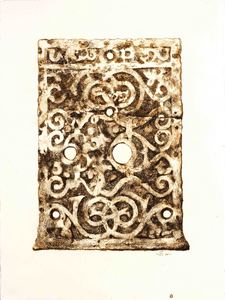Door Lock Plate (a drawing of an architectural feature from the old East Flinders Street printery found in the excavation site by the JCU Archaeological Department)
Brown, G. James (2012) Door Lock Plate (a drawing of an architectural feature from the old East Flinders Street printery found in the excavation site by the JCU Archaeological Department). [Creative Work] (Unpublished)
![[img]](https://researchonline.jcu.edu.au/23965/1.hassmallThumbnailVersion/DoorLockPlate.jpg)
|
Image (JPEG) ("Door Lock Plate" drawing of an architectural feature from the old East Flinders Street printery found in the excavation site by the JCU Archaeological Department)
Download (995kB) |
Abstract
"Door Lock Plate" by G. James Brown was executed as a contemporary response to the long tradition of Western architectural rendering. The drawing addresses the subject, conceptual focus, style and approach shown by artists such as Giovanni Battista Piranesi (1720–1778) from the standpoint of a contemporary North Queensland artist's perception of the an artefact found during excavations by the JCU Archaeology Department in Flinders Street, Townsville. By design, the drawing critiques the conventions of architectural rendering by comparing past practices to the artist's personal art practice. An article discussing this drawing and its context may be found at: http://www.printsandprinciples.com/2012/06/brown-kollwitz-three-analogues.html
Research Statement
| Research Background | This drawing extends my ongoing interest in examining relationships between current approaches in the Creative Arts (with a focus on North Queensland art practices) and historical precedents (with a focus on early European and English printmakers). I am fascinated how the motivations (e.g. choice of topic, subject and disposition of subject material) and technical processes (e.g. rendering styles, medium and format) are driven by culture, social issues and location (amongst others) and how these forces play significant roles in the creative process. The juxtaposition of my artworks with the prints by early artists highlights this concern with finding congruence and points of separation of artistic approach. |
|---|---|
| Research Contribution | This drawing contributes to current research by helping to define some key attributes of current art practice in North Queensland. By intention, the drawing clarifies some of the differences separating the practice of a North Queensland artist from those of early European and English printmakers, particularly the architectural prints of G.B. Piranesi (1720–1778). |
| Research Significance | Along with the drawings "Finial Base" and "Finial Crown" this drawing is the first to feature carbonised lemon juice as a drawing medium to show pictorial and conceptual connections between the working practices of a contemporary North Queensland artist and pictorial evidence perceived in the architectural prints of G.B. Piranesi. It is also likely to be the first architectural rendering demonstrating exploration of three approaches to using analogue compositional structures as shown in the online article: http://www.printsandprinciples.com/2012/06/brown-kollwitz-three-analogues.html |
| Item ID: | 23965 |
| Item Type: | Creative Work |
| Media of Output: | Pen, ink and lemon juice on watercolour paper, 76 x 57 cm |
| Keywords: | drawing, door lock plate, lemon juice, architectural rendering |
| Related URLs: | |
| Additional Information: | This work was exhibited in "From Model to Image" a solo exhibition by James Brown, 4-6 May 2012, eMerge Gallery, SoCA, James Cook University, Townsville. View the exhibition record at http://eprints.jcu.edu.au/24018/ |
| Date Deposited: | 04 Dec 2012 05:13 |
| FoR Codes: | 19 STUDIES IN CREATIVE ARTS AND WRITING > 1905 Visual Arts and Crafts > 190502 Fine Arts (incl Sculpture and Painting) @ 100% |
| SEO Codes: | 95 CULTURAL UNDERSTANDING > 9501 Arts and Leisure > 950104 The Creative Arts (incl. Graphics and Craft) @ 100% |
| Downloads: |
Total: 2145 Last 12 Months: 3 |
| More Statistics |



